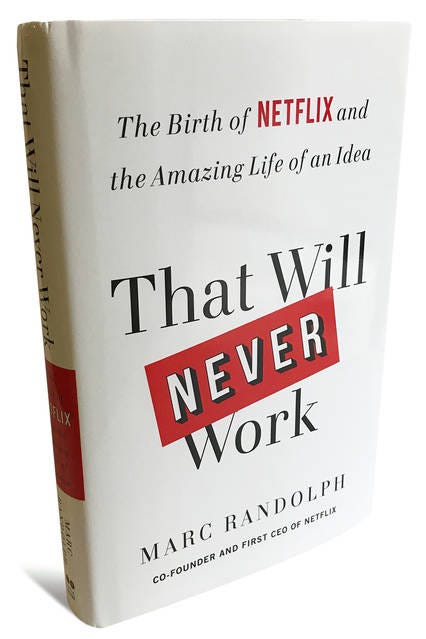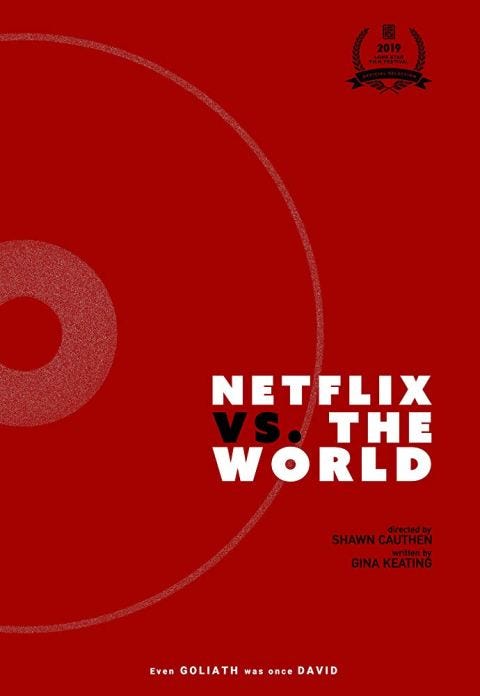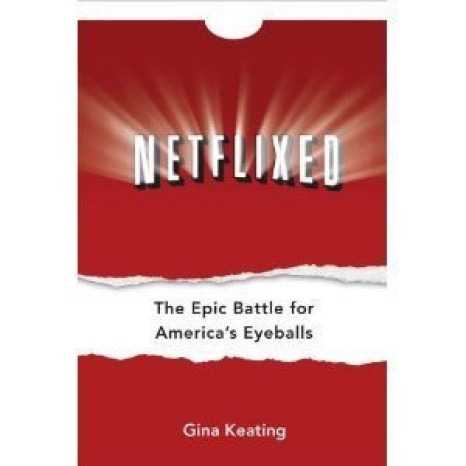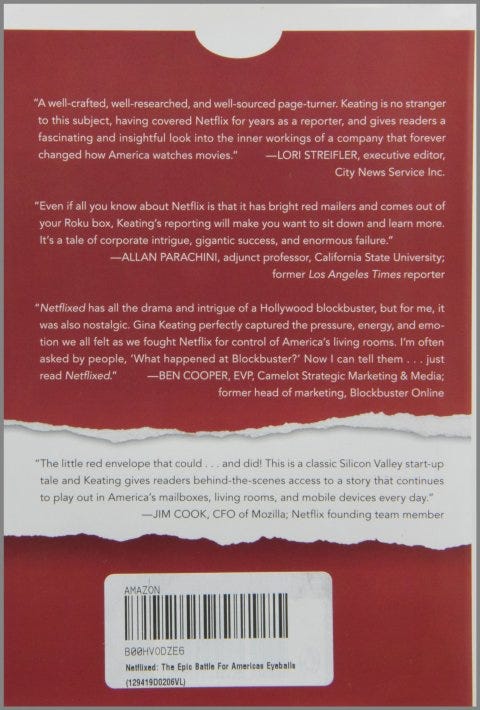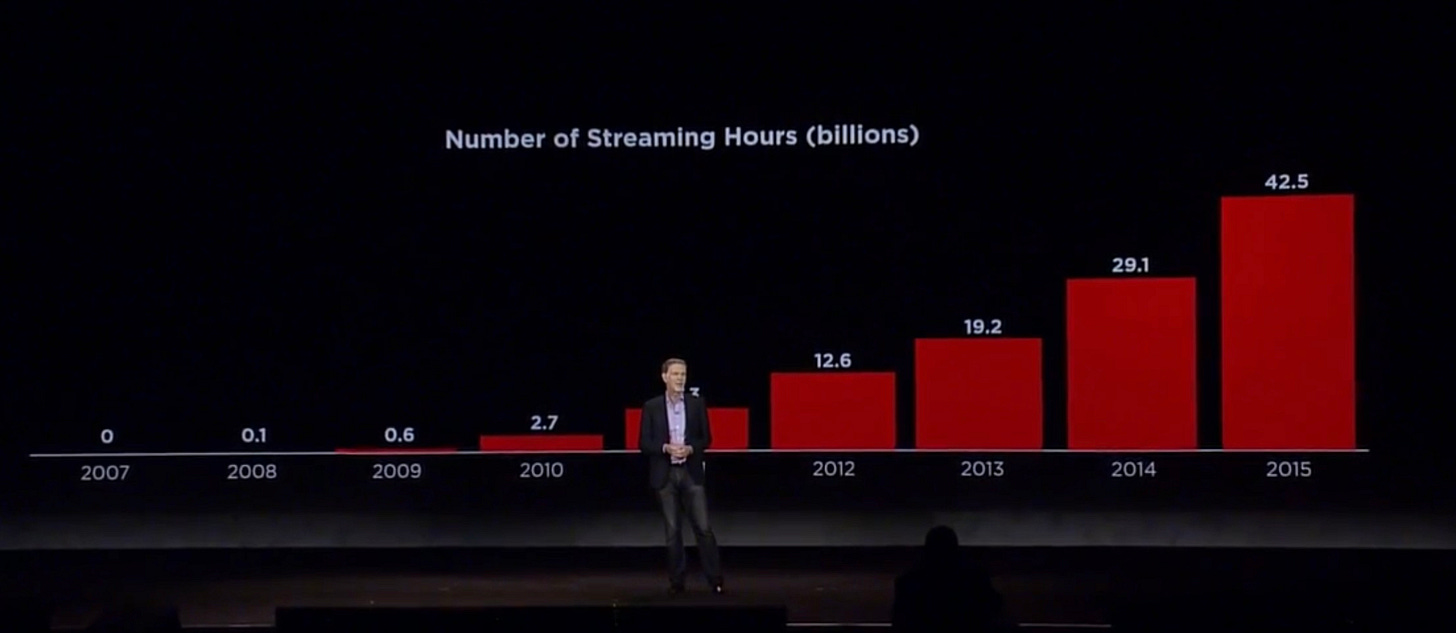That Will Never Work - Our Netflix Startup Story
The Birth of Netflix; 5 Lessons From My Netflix Startup Story; 5 Updated Lessons for 2025
Note: I first published this blog 6 years ago in 2019… and originally posted my “5 Lessons From Netflix StartUp Story” in 2006 (embedded below). Yes, you can find that on the interwebs - but I made it easier for you here. My “article” got a lot of air time in 2006, but I figured the “WayBack Machine” needed to be turned on to ensure the younger generation heard this story as well.
Cook’s PlayBooks is proud to partner with Brex, the modern finance platform built for high-performing CFOs. Brex unifies global cards, expenses, travel, procurement, banking, and bill pay into one AI-powered solution, giving finance teams the visibility, control, and speed to scale. Get started today and see how your peers are getting more leverage from finance with Brex.
“In the tradition of Phil Knight’s Shoe Dog comes the incredible untold story of how Netflix went from concept to company – all revealed by co-founder and first CEO Marc Randolph.
Once upon a time, brick-and-mortar video stores were king. Late fees were ubiquitous, video-streaming unheard of, and widespread DVD adoption seemed about as imminent as flying cars. Indeed, these were the widely accepted laws of the land in 1997, when Marc Randolph had an idea. It was a simple thought – leveraging the internet to rent movies – and was just one of many more and far worse proposals, like personalized baseball bats and a shampoo delivery service, that Randolph would pitch to his business partner, Reed Hastings, on their commute to work each morning.
But Hastings was intrigued, and the pair – with Hastings as the primary investor and Randolph as the CEO – founded a company. Now with over 150 million subscribers, Netflix’s triumph feels inevitable, but the twenty first century’s most disruptive start up began with few believers and calamity at every turn. From having to pitch his own mother on being an early investor, to the motel conference room that served as a first office, to server crashes on launch day, to the now-infamous meeting when Netflix brass pitched Blockbuster to acquire them, Marc Randolph’s transformational journey exemplifies how anyone with grit, gut instincts and determination can change the world – even with an idea that many think will never work.
What emerges, however, isn’t just the inside story of one of the world’s most iconic companies. Full of counter-intuitive concepts and written in binge-worthy prose, it answers some of our most fundamental questions about taking that leap of faith in business or in life: How do you begin? How do you weather disappointment and failure? How do you deal with success? What even is success?
From idea generation to team building to knowing when it’s time to let go, That Will Never Work is not only the ultimate follow-your-dreams parable, but also one of the most dramatic and insightful entrepreneurial stories of our time.”
Note: The above is republished from littlebrown.com. It’s the best excerpt to capture what “That Will Never Work” (published October 2019) is all about.
For those of you who didn’t know me 20+ years ago (1997 - I had just turned 30) “That Will Never Work” captures me quite well. I particularly love this quote…
I had the opposite problem with a man named Jim Cook — who ended up as one of the most important members of the Netflix team.
Page 40 is where my part of the story begins…
The original story of how we founded Netflix was published in 2012 by Gina Keating called “Netflixed” (below). Coincidentally, a documentary was made from this book and in Nov 2019 it was awarded “Best Documentary” at the Lone Star Film Festival.
Published in 2012 by industry journalist Gina Keating, “Netflixed” tells the story of how it all began. Gina sat down face-to-face independently with all us (the founding team members) and one-by-one we told our stories over the course of several months. We shared all our remaining artifacts/documentation (old envelopes, financial plans, old screen shots, 10 free rental coupons, etc) to help in her endeavor.
Gina painstakingly stitched all our stories together and added other industry interviews (Blockbuster, Walmart) and then followed through all the way to the recent strategic debacle (“Qwikster”) and the newest MBA case study of failed company splitting, price raising, and customer loyalty/brand destruction.
The resulting book gives us all an extremely accurate history of Netflix and yet another behind-the-scenes view of company building. It also provides a great opportunity for me to pull in an old blog post I wrote in 2006 as others have begun asking me again where they can find my old published article:
Five Lessons From the Netflix Startup Story
by Jim Cook
April 11, 2006
When we began building Netflix in 1997, most people thought we were nuts. DVD players had just started selling in the US in March, and by October we started executing our billion-dollar business plan with only $2 million in seed funding. Even with the dot-com era in full bloom, the idea of renting movies via mail struck most as somewhat ludicrous. Despite the odds and the obstacles, we persevered to create Netflix, which has revolutionized the movie rental industry.
Looking back on Netflix’s startup story, five customer-focused lessons stand out as critical in creating this innovative Internet business.
1. Don’t let the naysayers get you down
Starting a new company takes a lot of persistence, positive thinking, and a never-say-die attitude. Many experienced people gave us long lists of reasons why our business idea wouldn’t succeed.
Why would people wait for movies to come in the mail when they could just go down the street to Blockbuster? How can you cost-effectively mail out movies? Won’t they get broken, stolen, or damaged? Seeing the negatives is always the easy part. Solving such problems requires a special kind of creative stubbornness.
One by one, we went through the list of objections and eventually figured out each of them with unique solutions. Our customer research led us to several key customer insights, including the fact that over 60% of customers planned their video rental decisions. They knew what they wanted over a week in advance. We obsessed on our customized mailer packaging, our “per-package” economics, and 1-2 day delivery. The weight (and therefore cost) of the package was critical. We built everything from the ground up, step by step, and always with the end in mind.
We mapped the processing logistics of each package backwards. We started with the intimate knowledge of US Postal Service operations, then customized our software and operational technologies to automate our picking/packing/shipping and finally linked it all to our customer-facing website. We defined our operational culture by speed, weight, and daily process improvement. In short, we figured out a way to make it all work. If we had listened too hard to the naysayers and not stubbornly found a way around their objections, there would be no Netflix today.
2. Build operations for a “WOW” customer experience
We knew that if we didn’t find a way to work within the US Post Office’s systems, we wouldn’t succeed. We had to build operations to create an exceptional customer experience (the “WOW!”). To understand how the Post Office backend worked, I spent hundreds of hours at a few of the largest regional Postal Centers, observing and asking tons of questions.
I noticed letters being sorted by several high spinning circular drums. While these crushing metal drums enabled the separation and processing of over 40,000 standard size letters per hour, it was obvious that a thin plastic DVD would not survive the journey. With a sinking stomach, I felt the business idea slip away. But then I noticed a separate conveyor belt sorting magazines and other larger pieces of “flat mail.” How would I ensure that the package always used this flat mail machine and not the letter sorter?
I found out that if an envelope had certain dimensions and other characteristics, it would be sorted by this alternate system instead of the large, crushing metal drums. Better yet, this flat mail sorting machine would read a bar coded delivery address and could automatically sort the item into “carrier walking route” sequence. Now the wheels were really turning. The fact that we could provide the right-size packaging, bar code, and other characteristics would make it possible for extremely fast processing of a mail piece with absolutely no human intervention or other physical touch.
Our resulting “Netflix envelope” was one of our biggest “customer WOWs.” Its design was critical not only for the customer experience but also for our operations and business model. We had to design the envelope so that it met several criteria:
Naturally, it had to effectively hold and protect the DVD.
It had to meet stringent Post Office criteria so we could mail with the equivalent cost of a first-class stamp.
It had to transform into the return envelope so that DVDs would find their way back to Netflix quickly and in good condition.
It had to be “operational”—easy to insert and remove the discs and something that could be pre-printed in mass quantities.
Above all else, this envelope was our “product.” It was the only thing that our customers would touch and see. Therefore, it had to have all the key features of a great marketing piece.
Since 1998, there have been over 150 versions of this little red package. It wasn’t always red, but we determined that red was the easiest color to see in the post office. It wasn’t always paper thin—our first package was much thicker, and we shipped 3 DVDs in the same envelope. By testing, learning, and improving, we did such non-intuitive things like print the inside return address upside down to make processing more efficient. We had to build a mini “pocket” inside the package to ensure that the Post Office stamp-canceling machine wouldn’t break the DVD inside. A very recent change added a little cut-out on the outside of the package, enabling one to check the disc in by “seeing” the inside disc barcode without having to open the package. The amount of time and motion this one little step saves is enormous given today’s processing volumes of over 20 million DVD returns every month.
3. Develop three-step solutions
When I worked at Intuit in the early days, cofounder Scott Cook used to espouse the value of three-step (or less) solutions. Many high-tech products build in unnecessary complexity for consumers. By contrast, the most successful products take tedious and difficult chores and make them easy—so easy that consumers can solve their problems in three steps or less.
A great example of Netflix’s three-step solution is the now famous and patented Subscription Queue. We knew our success would be limited if we required customers to come back to our website every time to place their next rental order. Our research told us that the average video rental customer rented 5-7 movies per month. Why make that customer come back to our website each and every time to rent something they already knew they wanted and could simply put on a list?
So, in 1999, we created the first ever online queue—a list of movies that customer knew they wanted to eventually watch. Within a few short months, our customer base had an average of 20-25 movies in the queue—the research was right! Of course, now, we literally had to re-customize our operational software and website to enable this new subscription queuing process.
Our new ability to automatically send out the next movie on the list also served another key customer goal of reducing delivery time and always ensuring a customer had at least one Netflix movie to watch at all times. This offered service customers could get nowhere else. It was fast and it was easy.
4. Copy the best
Why reinvent the wheel if someone has already come up with an easy-to-use, useful, and elegant solution? When designing the Netflix website, we turned to the best: Amazon. Some of the ideas that we adapted for the Netflix website:
Product and button placements
Overall color schemes
Size of DVD images for fast page loading
Customer reviews and movie reviewer articles
Easy-to-use search with categorized searching by movie genre
Overall website navigation
5. Focus on rabid early adopters
It’s hard to believe, but Netflix launched and operated for the first five years without spending any significant advertising money. We had two secret weapons.
First, we had a meaningful connection with the rabid early DVD adopters on Usenet groups, the equivalent of early 90s bulletin boards and today’s blogs. When we launched our website, we made no public announcements. We hoped that this soft launch would bring in volumes of more than 10 or so “friends and family” orders per day. Unexpectedly, 500 orders arrived the first day, almost exclusively from our Usenet advocates who noticed the site was live and announced it to their networks. Within 30 days, we were consistently processing 1,000 orders per day, within three months over 2,000 orders per day, and thereafter continuing ahead of Amazon’s historical growth curve.
Our second key weapon was securing a coveted “ten free rental” coupon in every single DVD player sold by the big three manufacturers: Panasonic, Sony, and Toshiba. Combined, these big three had 85% market share. Ordinarily, it is extremely difficult to persuade major manufacturers to put promotional material in their packages. But at the time, these DVD player manufacturers were actually in fear of becoming another failed LaserDisc or Betamax. It was far from a foregone conclusion that DVD would catch on.
By offering 10 free rentals to consumers when they opened up their new DVD players, we gave consumers access to a breadth of titles that were very hard to find in traditional retail stores. We paid nothing out-of-pocket for the placement of the 5″ x 7″ purple branded coupon inserts. It was in the manufacturers’ interests to promote our service so that DVD technology wouldn’t die. We made sure that the coupons were the “last in” on the assembly line and therefore one of the first items a consumer would see upon opening their new DVD player.
Today, word of mouth still drives over 80% of all new customers. The customers are no longer early adopters, but they are just as rabid.
We started with an initial company goal of being bigger than the biggest single Blockbuster store in the US.
Today, the company’s market value is twice as big as Blockbuster’s. Netflix now boasts over 4 million customers and a market value of over $1.5 billion. Eight years later, the company is still quite young and services only 4% of all US households.
While the company faces many competitive pressures and a changing landscape of digital movie delivery, one thing is clear: Netflix’s relentless focus on customer-driven innovations will continue to provide the golden keys to unlock its revolutionary and evolving business.
Ok, that was the re-publishing of my original 2006 post. History is important after all as is updating lessons learned. So in that vein, here are 5 additional lessons for the modern day:
Five for 2025: A Few Updated Lessons for Today
It’s Never Too Late: I wrote the above originally in 2006 - so those 4 million customers and market valuation… well… let’s just say that 8-9 years in was still early. If you have a great idea… go for it. There are giants in the industry in your way? Just focus and build. Startups are all about constantly innovating.
Try the Rest; Buy the Best: Do this both professionally and personally. Be curious. Try all the options. Develop a clear personal point of view of what “the best” is and why. If your competitor’s products do stuff better than yours, then fix yours. Your goal is to simply be “the best” and then double/triple down on staying the best.
Out Innovate the Competition; Re-Invent Yourself… or somebody else will. Netflix may be one of the only historical case studies that literally put its original product out of business. They stopped shipping red envelopes in 2024. That product lasted over 25 years! Netflix went up against giants several times in its history and ended up winning every time. Envelopes, Streaming, Original Content, and now an advertising based pricing tier, and in 2025, Live TV and sports… which all brings me to my next key lesson of making big bets.
A graph speaks better than words on how Streaming reinvented Netflix starting in earnest around 2010… 13 years after the company was founded and 15 years ago.
Reed goes on to say above in Jan 2016 that Netflix had almost achieved reaching 50% of all US Households at the time… which means there was 50% more to reach! Worldwide in 2016, Netflix had reached 70 million homes. Today (2025) Netflix is in 300 million homes worldwide and is still only 80% of all US homes.
Make Big Bets:
Original Content Bet (2013): Very few in the industry or Wall Street analysts in 2013 thought Netflix would win the streaming wars against much deeper pocketed giants in Hollywood and Amazon. But Reed continued to bet the company again by taking on $6B in debt to begin making Netflix original content when it was clear that licensing Hollywood’s content to stream it was an eventual losing proposition. House of Cards in Feb 2013 cost Netflix an estimated $100M for the first season. One show, one season. This was the first of many “Big Bets.”
Today, Netflix’s long term debt on the balance is nearly $15B and their original content cash spend in 2025 is estimated to be $18B. That’s a long way from the $2M check we started Netflix with and the maximum valuation Blockbuster Video ever achieved as a public company over their 25 years of dominance at $5B market cap (2002) with their 9,000 stores and 65 million customers. By making these new huge original content bets, Netflix became the new Hollywood giant with their simple customer focus and technology innovations and by simply delivering a better product no matter how much it cost.
International Bet (2016): At the January 2016 CES conference, Reed keynoted and announced the international expansion with an intent to serve over 130 countries. Here’s a part of that transcript. Notice how even then it was about being a “global TV network” and not the biggest Hollywood movie studio.
“When we started Netflix nearly 20 years ago, we dreamed of the day when the Internet would enable us to deliver TV shows and movies to the billions of people with whom we share the planet.
While you have been listening to me talk, the Netflix service has gone live in nearly every country of the world, but China, where we also hope to be in the future. Today. Right now. You are witnessing the birth of a global TV network. And I do mean the birth.
Whether you are in Sydney or St. Petersburg, Singapore or Seoul, Santiago or Saskatoon, you now can be part of the internet TV revolution. No more waiting. No more watching on a schedule that’s not your own. No more frustration. Just Netflix—how, when and wherever you are in the world. Today, you have witnessed an incredible event.”
c. 2025’s “Big Bet” = Live TV and Sports: Netflix began experimenting with live TV and sports with WWE in 2024 and broadcasting their first NFL game in December of 2024. Nothing beats live sports. Netflix knows it and will be making some more big bets this year and the coming years.
Storytell the Future with Key Investor Narratives: Netflix has been (or will be) another case study on their long term investor narratives. Netflix was not cash flow positive until 2020. Think about the long term courage and investor narratives required for 20+ years of negative cash flow while also rolling out larger and larger big bets starting in 2013. Jeff Bezos/Amazon was the OG of this kind of investor narrative. Both blend the “long game” and clear long term vision with sophisticated stories that focus on long term metrics (% of households, engagement, original content ROI, global expansion %, and audience attention) amidst several periods of subscriber growth slowdown. Storytelling the future is required. The future is long term. Not next quarter or the next 12 months. Take a key lesson from Reed and Jeff Bezos and be bold!
Who knows, maybe I’ll update this post in 2030 to see where Netflix is by then and what more lessons we can all learn. Until then, keep reading Cook’s PlayBooks as I promise to continue to blend history to today and try to always bring you my “best ofs.”
For those of you who want to really geek out on history and Reed’s 2016 CES keynote - it’s chock-full of interesting Netflix tidbits from 9+ years ago and another great example of storytelling and delivering investor narratives.



